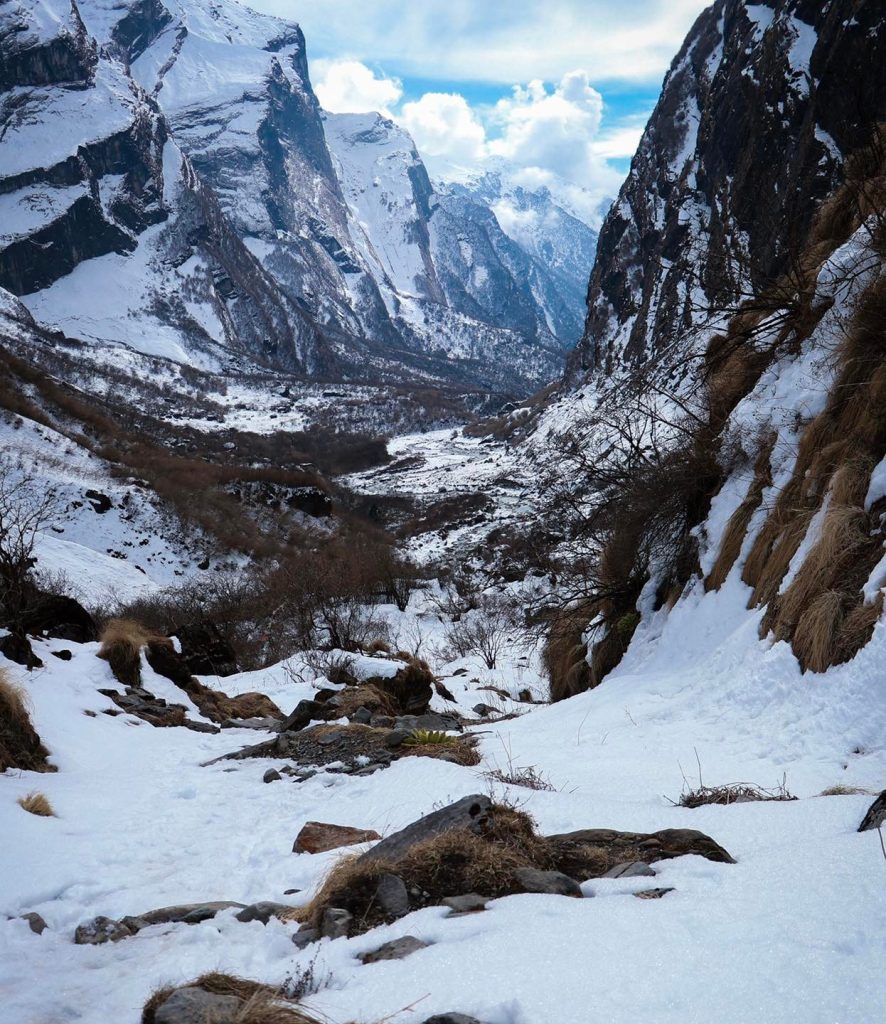Trekking the Annapurna Circuit in winter is a breathtaking experience that offers serene landscapes, clear mountain views, and a unique cultural immersion.
However, the harsh winter conditions present specific challenges that require thorough preparation and prompt action in case of emergencies.
This guide provides essential tips and strategies to help you stay safe and respond effectively during a winter trekking crisis, ensuring your adventure remains both safe and enjoyable.
Introduction
Winter Emergency Preparedness is crucial for anyone starting on a trek through the Himalayas. The Annapurna Circuit, renowned for its stunning vistas and cultural richness, becomes even more demanding in the winter months.
Trekkers face extreme cold, unpredictable weather, and heightened risks associated with high-altitude trekking. Being well-prepared for potential emergencies can mean the difference between a memorable adventure and a perilous situation.
In this guide, we will explore the various aspects of winter crisis management, from assembling a comprehensive emergency kit to developing an effective emergency plan. Whether you are a seasoned trekker or a first-time adventurer, understanding these strategies will enhance your safety and confidence on the trail.
Understanding Winter Emergencies in Trekking
Winter trekking on the Annapurna Circuit introduces a unique set of challenges that differ significantly from other seasons. Winter Crisis Management involves anticipating and preparing for emergencies that are made worse by cold weather and high altitudes.
Common Types of Emergencies
Avalanches: Heavy snowfall can trigger avalanches, especially in areas with unstable snowpacks. Avalanches pose immediate threats to trekkers, making awareness and preparedness essential.
Snowstorms: Sudden snowstorms can reduce visibility, increase temperatures, and make trails treacherous. Getting caught in a snowstorm without proper gear or shelter can lead to hypothermia and disorientation.
Altitude Sickness: The risk of Acute Mountain Sickness (AMS) increases with altitude and cold conditions. Symptoms include headaches, nausea, dizziness, and in severe cases, life-threatening complications like High-Altitude Pulmonary Edema (HAPE) and High-Altitude Cerebral Edema (HACE).
Frostbite and Hypothermia: Prolonged exposure to freezing temperatures can cause frostbite, damaging skin and tissues, and hypothermia, which affects the body’s core temperature regulation.
Impact of Winter Conditions
Winter conditions can amplify the severity of these emergencies. Limited daylight hours reduce the time available for trekking, increasing the likelihood of exhaustion and accidents. Additionally, fewer trekkers on the trail mean slower response times for rescue operations.
Real-Life Example: In January 2023, a group of trekkers encountered an unexpected avalanche near Thorong La Pass. Due to inadequate emergency preparedness, the team faced severe frostbite and hypothermia, requiring immediate evacuation by local rescue services. This incident underscores the critical importance of comprehensive winter emergency preparedness.
Creating a Comprehensive Winter Emergency Kit
A Cold Weather Emergency Kit is your lifeline during a winter trek. It should be lightweight, compact, and contain all the essentials needed to survive and manage emergencies until help arrives.
Essential Items for Your Emergency Kit
Thermal Clothing:
- Base Layers: Moisture-wicking materials to keep sweat off your skin.
- Mid Layers: Fleece or down jackets for insulation.
- Outer Layers: Waterproof and windproof jackets and pants to protect against the elements.
Survival Gear:
- Multi-tool: For repairs and various tasks.
- Fire Starter: Waterproof matches, lighters, and firesteel.
- Emergency Blanket: Reflective blankets to retain body heat.
Navigation and Communication:
- Satellite Phone or GPS Tracker: Essential for contacting rescue services.
- Maps and Compass: Reliable navigation tools in case electronic devices fail.
First Aid Supplies:
- Comprehensive First Aid Kit: Include items like bandages, antiseptics, pain relievers, and altitude sickness medications.
- Personal Medications: Ensure you have enough for the entire trek plus extra.
Food and Hydration:
- High-Energy Snacks: Nuts, dried fruits, energy bars.
- Water Purification Tablets: Safe drinking water is critical in emergencies.
Shelter and Warmth:
- Lightweight Tent or Bivy Sack: For protection against severe weather.
- Sleeping Bag: Rated for sub-zero temperatures with a warm liner.
Recommended Gear Brands
- Thermal Clothing: Patagonia, The North Face, Arc’teryx
- Survival Gear: Gerber, Leatherman
- Communication Devices: Garmin, Satellite Phone providers like Iridium
- First Aid Kits: Adventure Medical Kits, Lifeline
Organizing Your Emergency Kit
Organize your kit in a waterproof backpack with easy access compartments. Regularly check and maintain your gear to ensure everything is in working condition. Prioritize items based on necessity and accessibility during an emergency.
Developing an Effective Winter Emergency Plan
An Effective Emergency Plan is essential for responding swiftly and efficiently during a crisis. This plan should be personalized, taking into account the specific challenges of winter trekking.
Steps to Create Your Emergency Plan
Assess Risks: Identify potential emergencies you might encounter, such as avalanches, snowstorms, and altitude sickness.
Communication Strategy:
- Pre-Arrange Check-Ins: Establish regular check-in times with someone not on the trek.
- Emergency Contacts: Keep a list of local rescue services, your country’s embassy, and travel insurance contacts.
Define Protocols:
- Snowstorm Plan: Identify shelter locations and establish signals for help.
- Avalanche Response: Learn how to recognize avalanche-prone areas and perform self-rescue techniques.
Coordination with Local Rescue Services:
- Understand Procedures: Familiarize yourself with how local rescue teams operate during winter emergencies.
- Register with Authorities: Inform local authorities or trekking agencies of your itinerary.
Avalanche Safety Measures
- Recognize Signs: Learn to identify unstable snow layers and indicators of potential avalanches.
- Safe Zones: Know the safest areas to take cover if an avalanche occurs.
- Rescue Techniques: Understand basic avalanche rescue methods, including the use of probes and shovels.
Snowstorm Emergency Plan
- Shelter Identification: Locate the nearest shelters or safe zones along your trek.
- Stay Put or Move: Decide whether to stay in place or seek higher ground based on weather forecasts and trail conditions.
- Signal for Help: Use visual signals like mirrors or whistles to attract rescuers.
Essential Survival Tips for Winter Trekking
Surviving in extreme winter conditions require a combination of preparation, knowledge, and quick thinking. Here are some Winter Survival Tips to ensure your safety on the trail.
Preventing Hypothermia and Frostbite
- Layering: Use a three-layer system (base, mid, and outer layers) to regulate body temperature.
- Stay Dry: Avoid sweating by adjusting layers as needed. Wet clothing can lead to rapid heat loss.
- Protect Extremities: Wear insulated gloves, thermal hats, and waterproof boots to prevent frostbite.
Maintaining Body Warmth
- Keep Moving: Regular movement generates body heat, but avoid overexertion that can lead to sweating.
- Warm Meals and Drinks: Consume hot beverages and high-calorie foods to maintain energy levels.
- Use Hand Warmers: Portable hand warmers can provide additional warmth during breaks.
Handling Altitude Sickness in Winter
- Acclimatize Properly: Gradual ascent helps your body adjust to higher altitudes.
- Monitor Symptoms: Stay watchful for signs of AMS, such as headaches and nausea.
- Descend if Necessary: If symptoms worsen, descending to a lower altitude is crucial.
Staying Hydrated and Nourished
- Insulated Water Bottles: Prevent water from freezing by using insulated containers.
- Frequent Sips: Drink small amounts of water regularly to stay hydrated.
- Energy-Rich Foods: Choose foods that provide sustained energy, such as nuts, chocolates, and energy bars.
Communication and Navigation in Winter Emergencies
Effective communication and navigation are vital during a winter crisis. Ensuring you can contact help and navigate the terrain can save lives.
Reliable Communication Devices
- Satellite Phones: Provide connectivity in remote areas where cellular networks are unavailable.
- GPS Trackers: Enable rescuers to locate you quickly in case of an emergency.
- Two-Way Radios: Useful for communication within your trekking group.
Using Maps and GPS Effectively
- Pre-Download Maps: Ensure you have offline maps available on your GPS device.
- Compass Skills: Basic compass navigation skills are essential if electronic devices fail.
- Route Familiarity: Study your route in advance to reduce reliance on electronic navigation.
Tips for Signaling for Help
- Visual Signals: Use mirrors, brightly colored clothing, or distress flags to attract attention.
- Audible Signals: Whistles and horns can be heard over long distances, especially in snowy environments.
- Fire Signals: Building a controlled fire can serve as a powerful signal if safe to do so.
Understanding Local Rescue Procedures
- Rescue Timelines: Be aware of how long it typically takes for local rescue teams to respond.
- Helicopter Access: Know the landing zones and accessibility for rescue helicopters.
- First Responder Locations: Identify the nearest rescue points along your trek.
First Aid Essentials for Winter Treks
A well-stocked first aid kit tailored for winter emergencies is indispensable. It should address common injuries and ailments encountered during winter trekking.
Comprehensive First Aid Supplies
Basic Medical Supplies:
- Bandages, gauze, and adhesive tape
- Antiseptic wipes and ointments
- Pain relievers (e.g., ibuprofen, acetaminophen)
Cold-Related Treatments:
- Thermal blankets for hypothermia
- Burn cream for frostbite
- Hand warmers for additional warmth
Altitude Sickness Medications:
- Diamox (acetazolamide) for AMS prevention
- Portable oxygen canisters for severe cases
Personal Medications:
- Prescriptions and over-the-counter medications
- Extra supplies beyond the trek duration
Treating Common Winter Injuries
- Blisters: Use blister pads and tape to protect and cushion affected areas.
- Sprains and Strains: Provide support with elastic bandages and avoid putting weight on injured limbs.
- Frostbite: Gradually warm affected areas with body heat or warm water, avoiding direct heat sources.
Importance of First Aid Training
Understanding basic first aid can significantly enhance your ability to respond to emergencies. Consider taking a wilderness first aid course before your trek to gain essential skills and confidence.
Resources for First Aid Knowledge
- Magical Nepal Workshops: Enroll in our first aid training sessions tailored for trekkers.
- Online Courses: Platforms like Red Cross and Wilderness Medical Associates offer comprehensive first aid courses.
- Portable Guides: Carry a first aid manual or guidebook for quick reference during your trek.
Mental Preparedness and Decision-Making in Crises
Mental resilience and effective decision-making are critical components of Winter Emergency Preparedness. Staying calm and focused can help you navigate through crises efficiently.
Building Mental Resilience
- Positive Mindset: Maintain a positive attitude even in challenging situations.
- Stress Management: Practice breathing training exercises and meditation to manage stress.
- Visualization: Visualize successful outcomes and emergency responses to build confidence.
Strategies for Effective Decision-Making
- Stay Informed: Gather all available information before making decisions.
- Prioritize Safety: Always prioritize the safety of yourself and your group over completing the trek.
- Stay Calm: Keep a clear head to assess situations accurately and respond appropriately.
Importance of Staying Calm
Remaining calm during an emergency allows you to think clearly, communicate effectively, and implement your emergency plan efficiently. Panic can lead to poor decisions and exacerbate the situation.
Real-Life Case Studies and Lessons Learned
Analyzing real-life winter trekking emergencies provides valuable insights and lessons that can enhance your preparedness and response strategies.
Case Study 1: Avalanche Incident Near Thorong La Pass
Scenario: In January 2023, a group of trekkers was caught in an avalanche near Thorong La Pass. Due to inadequate emergency preparedness, the group faced severe injuries and frostbite.
Lessons Learned:
- Importance of Avalanche Awareness: Understanding snow conditions and recognizing avalanche-prone areas is crucial.
- Emergency Kit Necessities: Having essential items like avalanche probes and shovels can aid in rescue efforts.
- Swift Communication: Promptly signaling for help and maintaining communication with rescue services can expedite assistance.
Case Study 2: Snowstorm Stranding in Manang
Scenario: A snowstorm stranded a solo trekker in Manang for three days. Equipped with a well-stocked emergency kit and communication devices, the trekker was able to stay warm and eventually contact rescue services.
Lessons Learned:
- Comprehensive Emergency Kit: Including items like extra food, water, and thermal blankets ensures survival during prolonged emergencies.
- Reliable Communication Tools: Satellite phones and GPS trackers are vital for contacting help in remote areas.
- Self-Sufficiency: Being prepared to manage basic needs independently can significantly increase survival chances.
Applying Lessons to Future Treks
- Continuous Learning: Regularly update your knowledge on emergency preparedness and adapt strategies based on past incidents.
- Group Coordination: Practice emergency drills with your trekking group to ensure everyone knows their roles during a crisis.
- Proactive Measures: Implement preventive measures, such as monitoring weather forecasts and adjusting your trek plan accordingly.
Conclusion
Winter Emergency Preparedness is essential for ensuring a safe and enjoyable trek on the Annapurna Circuit. By understanding the unique challenges of winter trekking, assembling a comprehensive emergency kit, developing an effective emergency plan, and maintaining mental resilience, trekkers can navigate through crises with confidence and efficiency.
Magical Nepal is committed to supporting your trekking adventures with expert guidance and resources. Implement the strategies discussed in this guide to enhance your safety and make the most of your winter trekking experience. Remember, preparation is your best defense against the unpredictable nature of winter in the Himalayas. Safe travels and happy trekking!
Meta Description
Learn essential winter emergency preparedness tips for trekking in the Himalayas. Discover how to act quickly and effectively during winter crises with Magical Nepal’s comprehensive guide.



